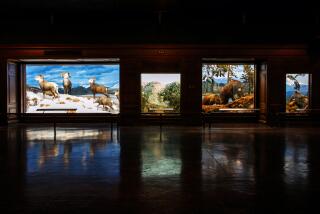Natural Treasures
No one sees Old Faithful or the Grand Canyon and forgets them.
Their images are burned into our imaginations and inextricably entwined with a sense of ourselves. Europe may have its castles and cafes but the United States has its geological wonders and vast stretches of wilderness, preserved by visionaries who fought to save what could so easily have been despoiled. Nature is our national treasure and an understandable source of our national pride.
As part of its ongoing exploration of how the West has shaped our cultural identity, the Autry Museum of Western Heritage in Griffith Park has mounted a fascinating new exhibit on the national parks.
Organized by Michael Duchemin, the museum’s curator of history, “Western Wonderlands: Touring America’s National Parks” gives visitors a better understanding of the history of the parks and how we have used them over the years. It also reminds us that in the United States, nature has been serving commerce for a very long time.
In the interactive exhibit, Duchemin has focused on five of the most photogenic parks--Yosemite, Yellowstone, Mesa Verde, Grand Canyon and Glacier National Park.
Since tourism is his theme, some of the most dramatic objects illustrate how millions of Americans get into the parks. Thus, a gleaming Ford station wagon--a “woody”--dominates one vignette, allowing visitors of a certain age to remember summer vacations that began with hours of squabbling with siblings in the back seat of the car and ended with the first unforgettable glimpse of the cliff dwellings at Mesa Verde or Yosemite’s Inspiration Falls.
The exhibit includes John Muir’s insight into the benefits Americans derive from their natural wonders: “Thousands of tired, nerve-shaken, over-civilized people are beginning to find out that going to the mountains is going home; that wilderness is a necessity; and that mountain parks and reservations are useful not only as fountains of timber and irrigating rivers, but as fountains of life.”
While the show includes awe-inspiring images of nature by painter Albert Bierstadt, photographer Eadweard Muybridge and others, it also allows us to see how getting to the parks has changed their very nature.
The earliest, non-Indian visitors came to these once remote wonders by rail (the show opens with the sights and sounds of a turn-of-the-century railroad station). And, by and large, early visitors had the leisure to travel and enough money for rooms and meals at the parks’ great rustic lodges. In the show, gowns, gloves, menus, posters, souvenirs and other artifacts bring these upper-class tourists to life.
Far less well-known than Teddy Roosevelt, John Muir and the other giants of environmentalism, Stephen Mather is a major figure in the show. The first director of the National Park Service, Mather left his distinctive stamp on the parks and indeed the nation. As the Huntington Library’s Peter Blodgett, a student of park history, points out, Mather was an ad man (one legend credits him with the “20,000-mule-team Borax” campaign), and “he knew how, in the older term, to ballyhoo a product.”
Mather’s product was the parks, and he ballyhooed them like crazy. He created a publicity machine that blizzarded the newspapers and magazines of America with press releases extolling the parks’ virtues.
In 1916, Mather democratized the national parks by opening them to automobiles. He also established relationships with auto clubs and other commercial ventures that depended on tourism. According to historians, Mather’s early decision to allow cars into the parks was a factor in everything from the development of interstate highways to the rise of the American motel industry.
Although visitors to the parks instantly become their advocates, those same visitors create traffic jams in Yosemite and Grand Canyon. The show reminds that the parks are being “loved to death.”
Millions now flock to the same parks that once saw a few hundred thousand visitors a year. More people go to Glacier each year than reside in all of Montana, according to historian Carlos A. Schwantes. In the mid-1950s, the number of visitors to Yellowstone each year was four times the population of Wyoming.
At the Autry, you can think about the national parks’ past, present and future. And, then, in the best National Park Service tradition, you can pick up a souvenir in the bookstore (the tackier the better) to remind you of your visit.
BE THERE
The Autry Museum of Western Heritage, 4700 Western Heritage Way, Griffith Park. Open 10 a.m.-5 p.m. Tue.-Sun. Admission is $7.50 for adults, $5 for seniors and students with valid I.D. and $3 for children 2-12. (213) 667-2000.
More to Read
Sign up for The Wild
We’ll help you find the best places to hike, bike and run, as well as the perfect silent spots for meditation and yoga.
You may occasionally receive promotional content from the Los Angeles Times.






